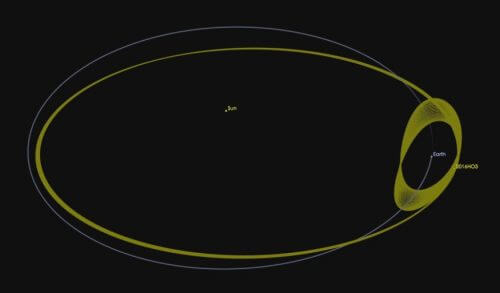A small asteroid in orbit around the sun that will stay with us for centuries to come

Great frustration was always hidden in the question "How is it that ours has one moon when even little Mars has two?". But let's not lose hope, because NASA announced these days that a second (approximately) second moon has been discovered. The very small "moon" discovered is actually an asteroid called 2016 HO3, and its rotation around the Earth is amazing in its irregularity. Asteroid 2016 HO3 was first detected by the Pan-STARRS 1 Asteroid Survey Telescope at Haleakala, Hawaii, on April 27, 2016.
This new asteroid orbits the Sun and in the process it also orbits the Earth. Its orbit is too far to be considered a true satellite of our planet, but it is the closest object to being our "quasi satellite" and also the most stable so far. The size measurements are still not well established, but according to NASA its width is greater than 36 meters and its length is no more than 91 meters. Right now it's locked in a sort of little figure eight dance with the Earth.
"Because the asteroid -- which loops around our planet -- never gets very far when both are orbiting the Sun, we treat it like a quasi-satellite of Earth," said Paul Chodas, director of NASA's Center for Nearby Object Studies. to Earth (NEO) at the Jet Propulsion Laboratory in Pasadena, California. “Another asteroid – 2003 YN107 – followed a similar orbital pattern for more than 10 years, but then left us. The new asteroid is more tightly 'locked' to Earth. Our calculations indicate that it has been a stable semi-satellite of the Earth for almost a century, and it will continue to accompany us in the same movement pattern for centuries to come."
2016 HO3's orbit around the Sun is highly elliptical. In its annual journey, it spends about half of the time closer to the Sun than the Earth, passing in front of the Earth and ahead of it, and in the other half of the time it is further away and lagging behind the Earth. Its orbit is also slightly tilted (8 degrees), and the tilt causes it to move in a 'jumpy' motion up and down once a year through the plane of the Earth's orbit. The duration of its rotation around the sun is 365.93 days, only slightly longer than the duration of the Earth's rotation - 365.24.
In addition to all these, the asteroid's orbit undergoes a slow twisting, back and forth, that lasts for many decades. Paul Chodes explains: "The loops that the asteroid makes around the Earth move a little forward or backward from year to year, but when they drift too far forward or backward, Earth's gravity is strong enough to stop the drift and hold the asteroid from wandering any further than 100 times the distance between us and the moon. The same effect also prevents the asteroid from coming closer than 38 times the distance to the moon."
That means in total, the distance of 2016 HO3 from us varies between 14 and 40 million km. In fact, this small asteroid is caught in a game of jumping with Earth that will last for centuries.
For information on the NASA website
The AsteroidWatch Twitter account

2 תגובות
I did not understand the orbit of the asteroid according to the video in the article. I found another video on youtube, I think it's clearer.. https://www.youtube.com/watch?v=DjRD1_o4CVg
How was this asteroid not discovered before?
If I remember correctly, there is a program to find such asteroids (there is even an Israeli scientist on the team, I remember from the Wize lecture I attended) so how come an asteroid that comes close to the Earth about once a year is not found?